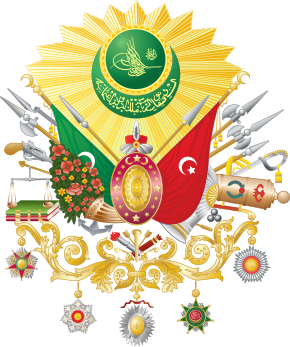Coat of arms of the Ottoman Empire
This article needs additional citations for verification. (May 2020) |
| Coat of arms of the Ottoman Empire | |
|---|---|
 | |
| Armiger | Sultan Abdul Hamid II |
| Adopted | 1882 |
| Order(s) | Medals of five of the Ottoman decorations |
| Other elements | Cornupia, anchor and scale |
| Use | Ottoman dynasty |
Every sultan of the Ottoman Empire had his own monogram, called the tughra, which served as a royal symbol. A coat of arms in the European heraldic sense was created in the late 19th century. Hampton Court requested from the Ottoman Empire a coat of arms to be included in their collection. As the coat of arms had not been previously used in the Ottoman Empire, it was designed after this request, and the final design was adopted by Sultan Abdul Hamid II on 17 April 1882.
Design[]
The emblem features an ornate cartouche ensigned by a Tughra. The cartouche is surrounded by various elements of the state including two flags: the red flag of the Anatolia Eyalet and the other Asian eyalets[1] with a star and crescent, and the green flag of the Rumelia Eyalet,[1] largely obscured by a cornucopia. Behind the flags are a number of spears and other weapons. In keeping with the Islamic proscription against depicting animate beings, no animals (such as supporters) are included in the design.
Hanging beneath the lower flourish are the medals of five of the Ottoman decorations.
- First writing is in Arabic "Mahmud Khan son of Abdülhamid, forever victorious". Written out: محمود خان بن عبد الحميد مظفر دائماً (Mahmūd Ḫān bin Abdulhamīd muẓaffar dāʾimā).
- Second writing in green big crescent is On the Ottoman coat-of-arms there is an Arabic inscription: "The King of Ottoman State relies on the guidance and assistance of the Almighty", written out as: ": المستند بالتوفيقات الربانية ملك الدولة العثمانية" (al-Mustanidu bi't-Tawfiqāti'r-Rabbānīyah Malik ad-Dawlatu'l-Alīyati'l-Uthmāniyah)[2]
Symbols[]
These are meaning of symbols[3]
- Green flag on the left: Rumelia Eyalet.[1]
- Red flag on the right: Anatolia Eyalet and the other Asian eyalets.[1]
- Elliptical figure in the middle and the turban above it symbolizes the Ottoman dynasty as the leader or caliph of all the Muslims in the World.
- Flowers on the left symbolize the Toleration of the Ottoman.
- Weight balance on the left symbolizes the Justice of the Ottomans
- Books on the left under the balance are a Quran and a Law book, symbolizing the Islamic state.
- Weapons on the left and right symbolize the Ottoman Armies.
- Sun symbolizes the greatness of the Ottoman state
- Green medallion on the Sun with the sultan's seal (Tughra) within symbolizes the great Ottoman dynasty.
- Green half-moon below the sultan's seal (Tughra) symbolizes that the Ottoman state is the guard of the all Muslims of the World.
- The board where medallions hang symbolizes the roots of the Ottoman State and Turkish culture.
- Medallions hanging in the bottom symbolize various ethnic nations within the empire.
Different designs[]
There are several different versions of the 1882 coat of arms:









Desk of Abdulhamid II
Pre-1882 coats of arms[]

1846[4]
See also[]
References[]
- ^ a b c d Sosyal Medyada Şeriat Bayrağı Diye Paylaşılan Bayrağın Aslında Rumeli'den Gelmesi (in Turkish)
- ^ Ottoman Archive: Ottoman Coat of Arms
- ^ "The Ottoman Military Sign | All About Turkey".
- ^ I.A.Tyroff, Wappenbuch der regierenden Monarchen Europas (Nürnberg 1846)
- Heraldry stubs
- Ottoman Empire stubs
- Coats of arms of former countries
- Government of the Ottoman Empire
- Ottoman culture
- National symbols of Turkey
- Turkish coats of arms
- 1882 introductions
- 1882 in the Ottoman Empire
- Coats of arms with flags
- Coats of arms with the star and crescent
- Coats of arms with books
- Coats of arms with weighing scales
- Coats of arms with spears
- Coats of arms with swords
- Coats of arms with anchors










